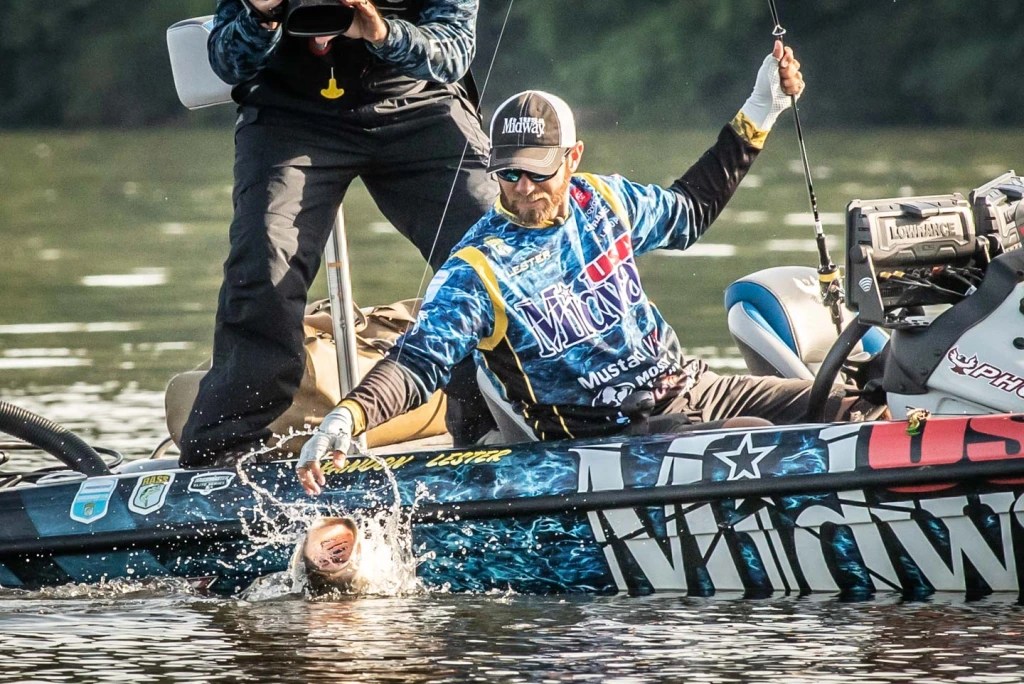
To most anglers, this is the best time of year to catch huge numbers of bass. With a few tweaks, you can focus on the monsters among them
As fall’s arrival brings that potent combination of declining temperatures and shortening days, bass feel the internal signal to start packing on weight and readying themselves for winter’s approach. Five Bassmaster Elite Series anglers share their insights into how they track down and engage autumn giants.
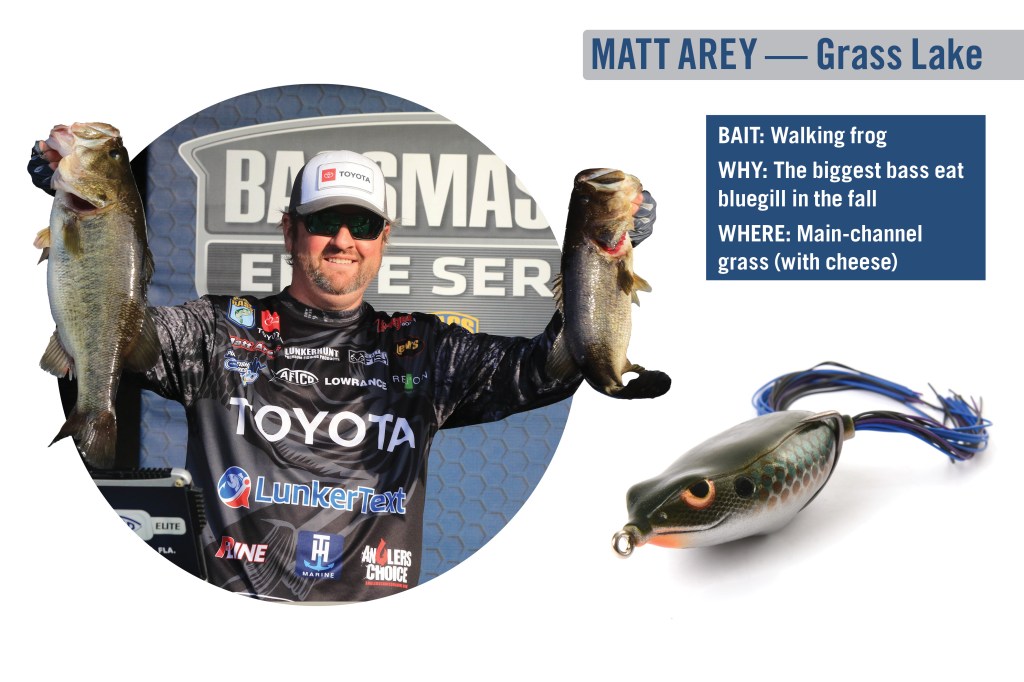
Matt Arey — Grass Lake
The grass-equals-bass adage is hardwired into Matt Arey’s logic board, but his is no random recital, particularly when fall cranks up the strategic feeding priority. In heavily vegetated lakes, a hungry fish won’t turn down an easy shad snack; however, experience has shown the North Carolina pro that his best shot at boating a true giant awaits within the shadowy realm populated by hefty meals.
“Separating good grass from bad grass can be overwhelming that time of year, but a lot of it has to do with the fact that it has a lot of life in it,” Arey said. “I want to find main-channel grass with good ‘cheese’ [yellowish algae growing on top of the grass]. You’ll see bream swimming around it; there are minnows swimming around the edge of it. You’ll see the occasional fish blow up in it.
“I would say a frog would be my main go-to bait here. That would be the way to target some of the biggest fish in the lake. When they’re feeding in that grass, those bluegill eaters are some of the biggest fish that time of year.”
Arey prefers the narrow nose of a walking frog, as it navigates the slop better than the popping style he reserves for open water. He’s not one to overthink the colors, as mat fishing generally prevents a bass from seeing a frog’s topside colors until it’s too late. That said, Arey believes in strategic selection.
“I do like something that is bluegill related, and the bottom of the frog, which we call the ‘business part of the frog,’ is usually an off-white,” he said. “If you look at most bream, they turn to either a light yellow or off-white on their bellies. The back of the frog doesn’t matter as much.”
Adding internal weights pulls a frog lower and makes a deeper impression in the mat — often a difference-maker that helps fish track the bait. Arey often throws a Lunkerhunt Compact Frog for its scaled-down body and shorter legs. With a full-size frog, he suggests shortening the legs to help a fish catch the bait.
“I like to offer the fish a compact target because when they’re coming up blasting through grass, I want my hookup ratio as high as it can be,” Arey said. “Trimming the legs also allows you to walk a frog a little easier when you get to an open hole in the grass.
“One thing I’ve done is trim one leg shorter than the other. That will allow the frog to turn a little more in those open spots.”
BAIT: Walking frog
WHY: The biggest bass eat bluegill in the fall
WHERE: Main-channel grass (with cheese)
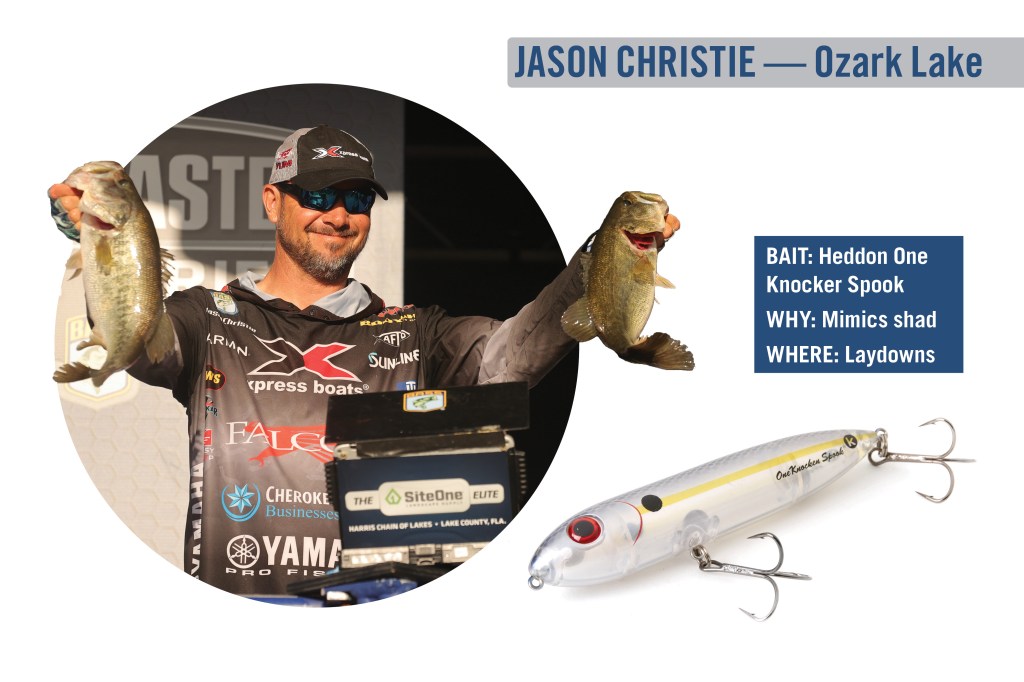
Jason Christie — Ozark Lake
While fall feeding typically resembles that retail nightmare known as Black Friday, the defending Bassmaster Classic champ knows that the lake’s biggest fish are more discerning customers. Basically, it comes down to the “me first” attitude that allowed them to grow big in the first place.
“I would look for isolated cover, whether it be an isolated stump, an isolated dock or some other piece of cover,” Christie said. “They just want to own something. You can catch a big one anywhere, but if you start running isolated targets, that’s where you’re going to have a chance to catch a big one.”
With heavy feeding as their No. 1 priority, fish will instinctively use cover. However, Christie knows the value of taking a highly discerning approach to target selection.
“That’s the time of year where they prefer bait over cover, but if you can find a combination of the two — some isolated cover around bait — that’s where you’re [likely to] catch a big one,” Christie said. “You might be running down the lake and there might be a pocket with 15 docks in it and a pocket on the other side of the lake just has one.
“It’s kind of the same way with laydowns. If there’s a stretch with 25 laydowns and then over here there’s two, there’s just something about isolation.”
Shad imitations are hard to beat for the fall season, and Christie’s favorite is a Heddon One Knocker Spook. A big, visual target with the moves of an ambling — maybe injured — baitfish and an enticing heavy-knocking sound, this bait creates an enticing/irritating presence that sends big fish right over the edge.
As long as the day’s at least partly sunny, Christie’s going to cast to the target’s shady side. Big territorial fish are typically quick to respond, but he’ll base his casting frequency on the type of cover.
“It’ll vary based on water depth, but if you have a stump in 2 feet, he’s probably going to get it on the first cast,” Christie said. “If you have a dock in 7 to 8 feet, you may want to make quite a few casts
BAIT: Heddon One Knocker Spook
WHY: Mimics shad
WHERE: Laydowns
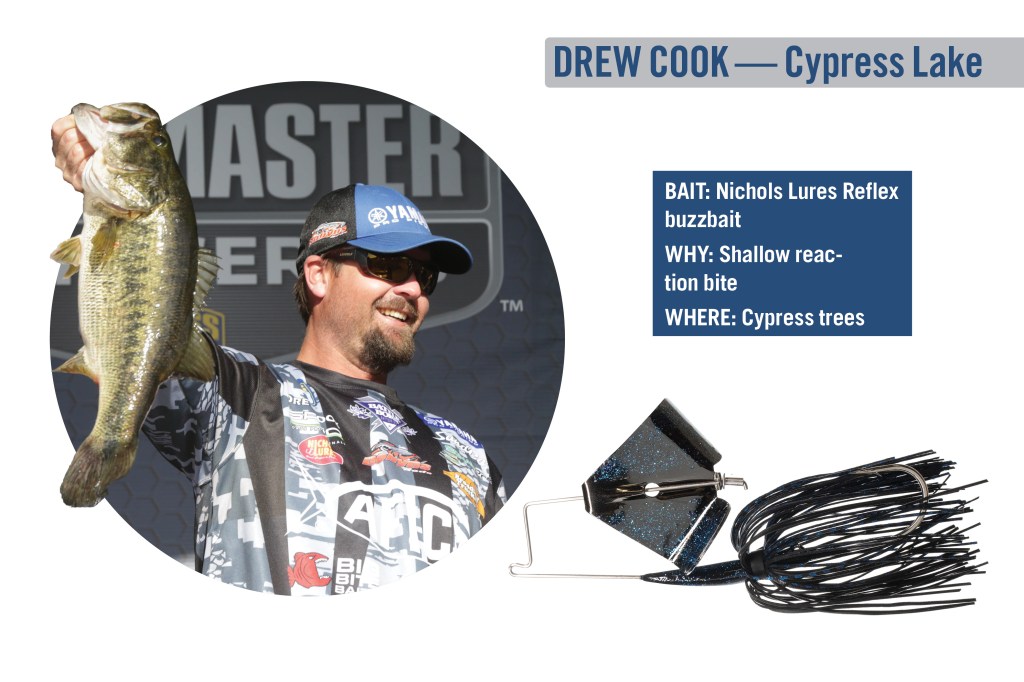
Drew Cook — Cypress Lake
When he’s seeking the often solitary beasts hiding amid the bald cypress rimming a Southern fishery, Cook predictably begins his search on points located near current. It could be river flow or wind current; either way, cover plus food delivery makes for a solid fall formula.
“I also want deep water close by, and I prefer an isolated group of cypress trees out of the way,” Cook said. “A spot where you would have to leave [the main treeline] to get to it — that’s a high-percentage spot because it probably doesn’t get a lot of pressure.”
No two cypress trees are alike, but Cook’s discerning eye is mostly looking for those with forms that serve the fish’s preference while discouraging close-range angling efforts. Cypress tree perimeters — including the knees — definitely produce, but Cook’s big on skipping baits deep into the shadowy realms where big fish park.
That’s why he likes a tree with a full skirt of branches hanging low to the water. This setup not only holds the fish in comfortable accommodations; it also intimidates a lot of anglers from venturing a cast.
Cook adds another search-refining criteria: “I like to see spiderwebs. If I find two trees with spiderwebs between them, I know no one has been there.”
When he dials in a sweet spot, Cook’s go-to for this early fall scenario is a buzzbait. In this relatively shallow habitat, a 1/4- to 1/2-ounce bait works, and he’ll go with either a noisy Nichols Lures Reflex (head-slammer style) or a quieter Nichols Lures Impulse (nonclacker).
“I’ll fish both of these buzzbaits without the skirt and [with] a Big Bite Baits Tour Toad,” Cook said. “I’ll use a white toad if there’s a lot of shad around, and if there’s more bream, I’ll go with black.”
Strategically, Cook always throws his Reflex first, as this highly intrusive bait will aggravate the aggressive fish for immediate bites. If he likes an area enough for a second pass — maybe a return later in the day — he’ll throw the Impulse as a cleanup bait to taunt the more reticent fish.
BAIT: Nichols Lures Reflex buzzbait
WHY: Shallow reaction bite
WHERE: Cypress trees

Brandon Lester — TVA Lake
Matted grass — not every lake in the system has it, but using Guntersville as his example, Lester said he believes punching a dense line of vegetation offers his greatest opportunity of locking horns with a straight-up day-maker. Fall will find a lot of fish following shad schools into the backs of creeks, but a lot of them stick with the vegetation.
Lester’s rig of choice is a Zoom Z Craw Jr. on a 3/0 Mustad Grip-Pin Max hook and a 1 1/2-ounce tungsten weight. He favors this bait because it checks the boxes that matter.
“You want a bait that’s small and compact; it has a good action and it’s easy to get a hook through — it has a good hookup ratio,” Lester said. “When you’re punching, you don’t want a big bait with a bunch of appendages going every which way; you want a bait that’s streamlined.
“I like a bait with a little leg kick to it, and the way the Z Craw Jr. is designed, it has two little flappers on the back that are still very streamlined, but you still get some action out of it while that bait is falling.”
Considering how punching presents a pure reaction premise, Lester keeps his colors supersimple: green pumpkin for sunny times and black/blue for early mornings, late afternoons or overcast conditions. If he’s hearing a lot of bluegill in the mats, he’ll add a small touch of Spike-It chartreuse dye to the bait’s tips.
“I like to fish main-river grass mats if I can find them because I find that’s where your truly giant fish are going to be,” Lester said. “I feel like matted hydrilla is the best, but milfoil will also work. I’ve caught them out of matted eelgrass and several different types of grass.”
Whatever the composition, Lester treats a fall grass mat just as he would a shoreline. Too much sameness can mean a lot of punching without much to show for it; whereas, pronounced irregularities — turns, points, isolated patches of different vegetation or the edges of an open spot — comprise the more likely targets.
“My pace is pretty standard; I’m just covering water until I get a few bites, then I may really slow down and try to pick an area apart,” Lester said. “They’re going to get positioned better as the day goes on, but I’ve caught them first thing in the morning.”
BAIT: Zoom Z Craw Jr.
WHY: Small profile is perfect for punching, and legs offer good kick
WHERE: Main-river grass mats
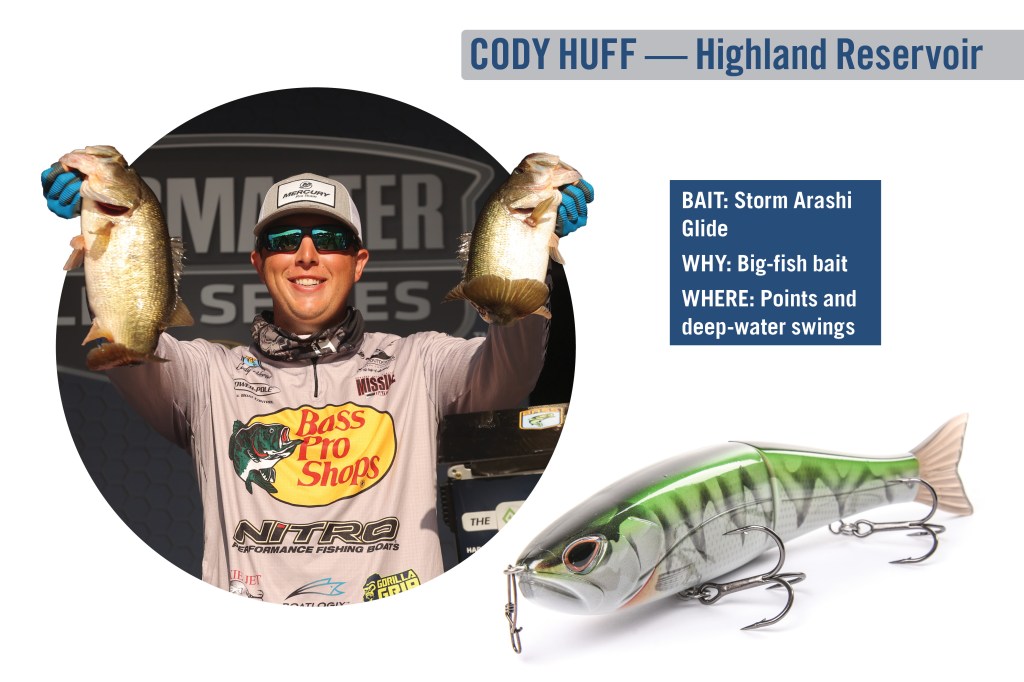
Cody Huff — Highland Reservoir
With bait schools moving up from deep water en route to creeks and pockets, Huff wants to keep himself right on those transition areas to capitalize on the early fall buffets. Whether it’s gizzard shad, crappie or bluegill, wherever he finds the food stacked, the Elite rookie from Missouri knows just how to entice the whoppers.
“When you’re trying to catch a big fish, it’s hard not to pick up a Storm Arashi Glide,” Huff said. “Especially in the fall, they’re just not that active, and you need something pretty big to make those fish react. As long as they’re eating some sort of big baitfish, a [glide bait] will work.”
Highland reservoirs typically boast significant visibility, so Huff makes his color selections based on the level of clarity he finds. If he can see 6 feet or more, he’ll throw a translucent bluegill color; but if visibility is about 5 feet or less, he wants something with more eye appeal. Black silver shad or pro blue gets the call here.
“I usually try to stick somewhere near deep water because they’ve been deep for the summer and a lot of the baitfish are working their way back in,” Huff said. “Steep bluff ends, points and the first couple of deep-water swings in the creeks with shallow secondary points next to them — those are all good places to throw that glide bait.
“Cover doesn’t really matter, as long as you have the right contours, but it doesn’t hurt if you have a laydown or a rough patch of rocks. You just have to hit enough of those spots so you find something like that.”
No question, forward-facing sonar plays a big role in Huff’s fall game plan and, while spotting fish certainly helps, he’s largely dependent on his Garmin LiveScope to stay near the baitfish. Keeping his focus on areas with a lot of life keeps his probability high.
“When I’m randomly going down the bank, I’ll turn and look toward my bait, so whenever I get a fish up after that glide bait, I can see where they’re coming from and what they’re coming off of,” Huff said. “Even if they don’t bite, you can watch and see where they go back to.
“This helps me see where those fish are setting up so I can make a better cast to them. If I am fishing an actual target, I like to cast way past it so they don’t see a big splash right over their head. I want the bait to surprise them, not startle them.”
BAIT: Storm Arashi Glide
WHY: Big-fish bait
WHERE: Points and deep-water swings
Originally appeared in Bassmaster Magazine 2022.





